Smart Cockpit Design Trend Research: Moving to the third living space
With the continuous development of cockpit hardware and software technology, intelligent cockpit design is evolving, pivoting from functionality to "user experience". Intelligent cockpits are becoming more and more secure, smart and comfortable.
In terms of perception, the cockpit display is not limited to multi screens and large screens, 3D screens and high-definition screens are also emerging.
For cockpit display, multi screens and large screens still prevail. From 2020 to 2021, emerging automakers and traditional automakers have successively launched a number of models equipped with multiple screens and joint screens. For example, Hongqi E-HS9 was equipped with 8 screens at the end of 2020. In 2021, Human Horizons mass-produced and delivered HiPhi X equipped with 9 screens. At the same time, the screen size in the car is getting larger and larger. The center console of Xingyue L, launched in July 2021, has a 1-meter IMAX screen. The center console of Ford EVOS that is planned to be launched in October 2021 will feature a 27-inch 4K display. Cadillac Lyriq to be launched in 2022 will have a 33-inch all-in-one display.
In addition, the screen layout has become more novel and unique. In early 2021, Mercedes-Benz revealed the MBUX Hyperscreen, whose three displays merge almost seamlessly into one another to create an impressive screen band over 141 centimeters wide: Driver display (screen diagonal: 12.3 inch), central display (17.7 inch) and front passenger display (12.3 inch) appear as one visual unit. Three screens sit under a common bonded irregular curved cover glass. For particularly brilliant display quality OLED technology is used for the central and front passenger displays. The MBUX Hyperscreen embodies a strong sense of technology.
EQS Smart Cockpit of Mercedes-Benz
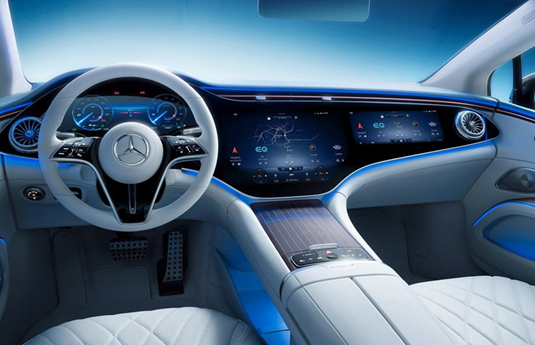
Source: Internet
The IM L7, which is planned to be mass-produced in 2022, is equipped with a 39-inch smart scenario screen and a 12.8-inch AMOLED center console screen. The 39-inch screen is composed of two joint screens, which can be raised and lowered separately with multiple display modes and allow the content to be switched without boundaries.
Smart Cockpit of IM L7
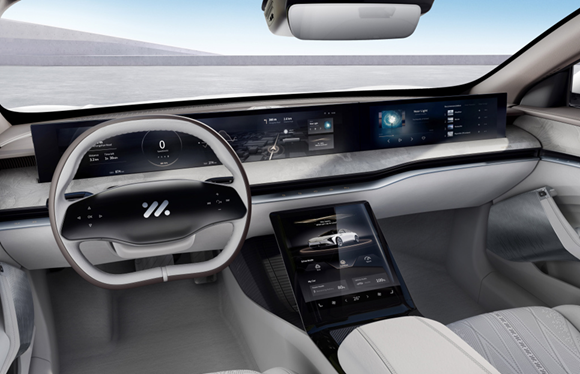
Source: Internet
Driven by high-definition mobile phone displays, consumers have more views on the resolution of automotive displays. Low-resolution displays can no longer meet the needs of the current users. Automotive displays tend to feature higher resolution, higher contrast, wider field of view, more optical indicators, and faster response. In the BMW iX scheduled to be launched at the end of 2021, the new iDrive 8 will come with horizontal curved dual screens: a 12.3-inch LCD cluster screen and 14.9-inch IVI screen (the angle is slightly inclined towards the driver). BMW says screens used in the new system will have a pixel density of 206 pixels per inch (PPI).
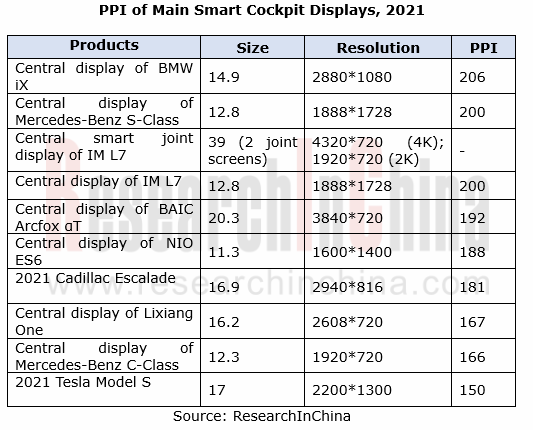
HMI capabilities develop from functional perception interaction to cognitive and active interaction
The HMI UI interface design for automobiles is changing on the basis of practical functions. With more and more functions, smart cars are getting cleverer, and the underlying data is more and more abundant. In the future, interface interactions will be more concise, 3D intuitive, younger, transparent, digitized, and symbolized, flattened and the like. In June 2020, Banma SmartDrive released the Venus Intelligent System whose UI interface adopts the design concept of A-B parallel worlds. World A takes a "map as a desktop", while World B uses a waterfall layout. Users can intuitively find commonly used functions on the interface, and even set the display interface as what they want.
Venus Intelligent System of Banma SmartDrive - AB Worlds
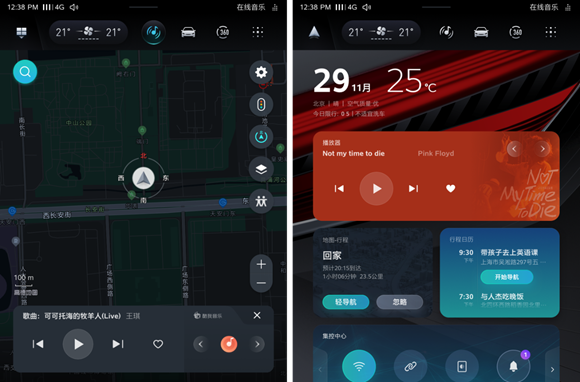
Source: Banma SmartDrive
MBUX Hyperscreen can display the desired personalized functions for users on the main interface of the central screen at an appropriate time, enabling "zero-layer" operation without scrolling or turning pages, bringing relaxed and intimate HMI experience.
"Zero-layer" Interactive Interface of Mercedes-Benz MBUX Hyperscreen
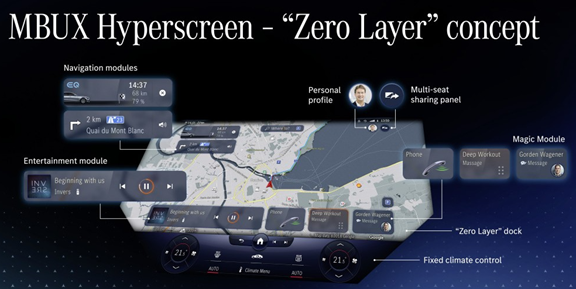
Source: Internet
Innovation and breakthroughs in UI interface design are inseparable from the development of HMI design tools. In terms of HMI design and development tools, many companies have released the latest products. Lately, HMI design and development tools feature multiple platforms, multiple algorithms, reusable software framework, 3D interface design, etc. In addition, with the creation of the third space of the smart cockpit and the continuous improvement of entertainment, technology HMI design companies such as web game companies like Eptic Games have dabbled in the automotive market.
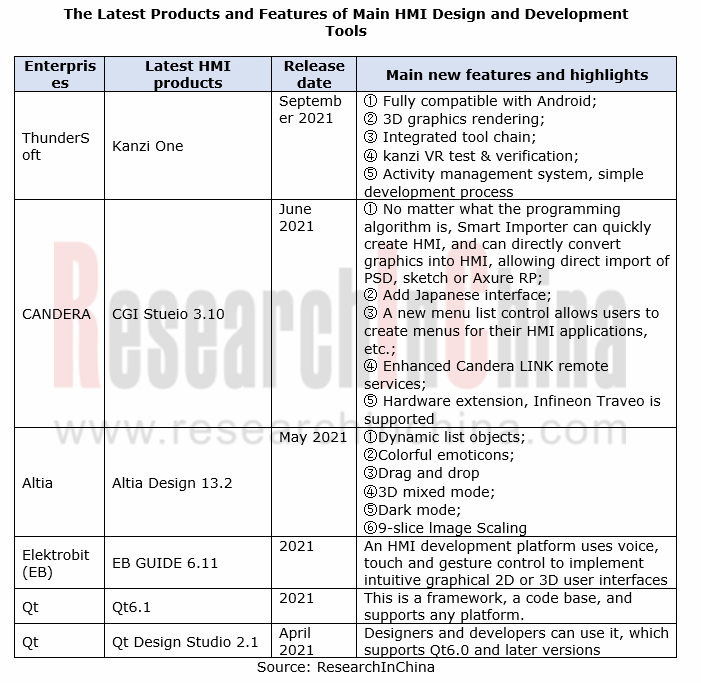
Through the fusion applications of AI, smart atmosphere lights, smart surface materials, fragrance systems, smart seats and other products and technologies, voice, AI assistants, face recognition, gestures, face, fingerprint, vital signs detection and other HMI technologies and models have been available in cars. The smart cockpit has certain HMI experience and scenario-based capabilities, and the cockpit scenario interaction is more intelligent, emotional, and humane. HiPhi X, which was mass-produced and delivered in 2021, can recognize the driver's expression, voice, heart rate, blood oxygen, blood pressure, breathing rate, etc. through 52 biosensors, and then adjust music and temperature, or take over the vehicle in dangerous situations.
At CES 2021, Samsung exhibited a digital cockpit equipped with Automotive Samsung Health, which analyzes passengers’ health status before boarding by utilizing a combination of cameras and wearable and mobile devices installed in the vehicle. In the car, it also regularly monitors passengers’ stress levels and will adjust the vehicle’s lighting, scent, or music in an effort to help them relax.
2021 Samsung Digital Cockpit with Automotive Samsung Health
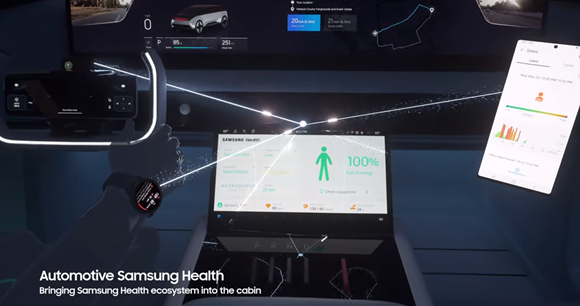 Source: Internet
Source: Internet
With the HMI design concept focusing on "user experience", HMI is developing from basic functional perception interaction to cognitive and active interaction through AI, in-car and out-of-car perception technologies.
Smart cockpits realize custom programming through SOA software
Since smart cockpits are designed as per human-oriented user experience, personalization will become a major development trend of smart cockpits in the future. In addition to the basic personalized custom settings such as the initial IVI system and buttons, the software architecture can help realize the personalized custom settings of multiple scenarios in the car. For example, the WM W6, which was launched at the Shanghai Auto Show in 2021, WM W6 realizes personalized combinations and settings of scenarios based on SOA software and through APP custom programming.
Custom Scenario Programming Card for WM W6
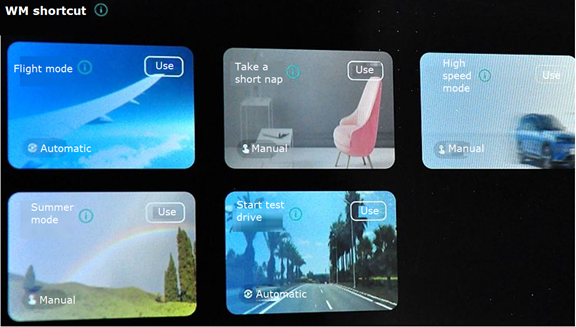
Source: WM
OEMs and Tier 1 Suppliers' Cost Reduction and Efficiency Enhancement Strategy Analysis Report, 2025
ResearchInChina released the "OEMs and Tier 1 Suppliers' Cost Reduction and Efficiency Enhancement Strategy Analysis Report, 2025", summarizing hundreds of cost reduction strategies to provide referen...
Automotive Fixed Panoramic Sunroof and Smart Roof Research Report, 2025
With the intelligent application of car roofs as the core, this report systematically sorts out a series of new products such as fixed panoramic sunroof/openable sunroof, ceiling screen, roof ambient ...
Automotive-Grade Power Semiconductor and Module (SiC, GaN) Industry Research Report, 2025
SiC/GaN Research: Sales volume of 800V+ architecture-based vehicles will increase more than 10 times, and hybrid carbon (SiC+IGBT) power modules are rapidly being deployed in vehicles.
Sales volume o...
Cockpit Agent Engineering Research Report, 2025
Cockpit Agent Engineering Research: Breakthrough from Digital AI to Physical AI
Cockpit Agent Engineering Research Report, 2025 starts with the status quo of cockpit agents, summarizes the technical ...
Prospective Study on L3 Intelligent Driving Technology of OEMs and Tier 1 Suppliers, 2025
L3 Research: The Window of Opportunity Has Arrived - Eight Trends in L3 Layout of OEMs and Tier 1 Suppliers
Through in-depth research on 15 OEMs (including 8 Chinese and 7 foreign OEMs) and 9 Tier 1 ...
China Commercial Vehicle IoV and Intelligent Cockpit Industry Research Report 2025
Commercial Vehicle IoV and Cockpit Research: The Third Wave of Passenger Car/Commercial Vehicle Technology Integration Arrives, and T-Box Integrates e-Call and 15.6-inch for Vehicles
I. The third wav...
Intelligent Vehicle Electronic and Electrical Architecture (EEA) and Technology Supply Chain Construction Strategy Research Report, 2025
E/E Architecture Research: 24 OEMs Deploy Innovative Products from Platform Architectures to Technical Selling Points
According to statistics from ResearchInChina, 802,000 passenger cars with domain...
Research Report on Intelligent Vehicle Cross-Domain Integration Strategies and Innovative Function Scenarios, 2025
Cross-Domain Integration Strategy Research: Automakers' Competition Extends to Cross-Domain Innovative Function Scenarios such as Cockpit-Driving, Powertrain, and Chassis
Cross-domain integration of ...
China Autonomous Driving Data Closed Loop Research Report, 2025
Data Closed-Loop Research: Synthetic Data Accounts for Over 50%, Full-process Automated Toolchain Gradually Implemented
Key Points:From 2023 to 2025, the proportion of synthetic data increased from 2...
Automotive Glass and Smart Glass Research Report, 2025
Automotive Glass Report: Dimmable Glass Offers Active Mode, Penetration Rate Expected to Reach 10% by 2030
ResearchInChina releases the Automotive Glass and Smart Glass Research Report, 2025. This r...
Passenger Car Brake-by-Wire (BBW) Research Report, 2025
Brake-by-Wire: EHB to Be Installed in 12 Million Vehicles in 2025
1. EHB Have Been Installed in over 10 Million Vehicles, A Figure to Hit 12 Million in 2025.
In 2024, the brake-by-wire, Electro-Hydr...
Autonomous Driving Domain Controller and Central Computing Unit (CCU) Industry Report, 2025
Research on Autonomous Driving Domain Controllers: Monthly Penetration Rate Exceeded 30% for the First Time, and 700T+ Ultrahigh-compute Domain Controller Products Are Rapidly Installed in Vehicles
L...
China Automotive Lighting and Ambient Lighting System Research Report, 2025
Automotive Lighting System Research: In 2025H1, Autonomous Driving System (ADS) Marker Lamps Saw an 11-Fold Year-on-Year Growth and the Installation Rate of Automotive LED Lighting Approached 90...
Ecological Domain and Automotive Hardware Expansion Research Report, 2025
ResearchInChina has released the Ecological Domain and Automotive Hardware Expansion Research Report, 2025, which delves into the application of various automotive extended hardware, supplier ecologic...
Automotive Seating Innovation Technology Trend Research Report, 2025
Automotive Seating Research: With Popularization of Comfort Functions, How to Properly "Stack Functions" for Seating?
This report studies the status quo of seating technologies and functions in aspe...
Research Report on Chinese Suppliers’ Overseas Layout of Intelligent Driving, 2025
Research on Overseas Layout of Intelligent Driving: There Are Multiple Challenges in Overseas Layout, and Light-Asset Cooperation with Foreign Suppliers Emerges as the Optimal Solution at Present
20...
High-Voltage Power Supply in New Energy Vehicle (BMS, BDU, Relay, Integrated Battery Box) Research Report, 2025
The high-voltage power supply system is a core component of new energy vehicles. The battery pack serves as the central energy source, with the capacity of power battery affecting the vehicle's range,...
Automotive Radio Frequency System-on-Chip (RF SoC) and Module Research Report, 2025
Automotive RF SoC Research: The Pace of Introducing "Nerve Endings" such as UWB, NTN Satellite Communication, NearLink, and WIFI into Intelligent Vehicles Quickens
RF SoC (Radio Frequency Syst...